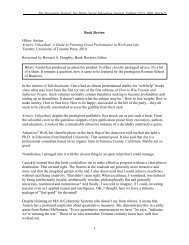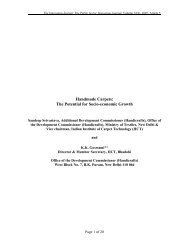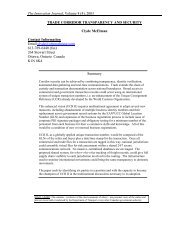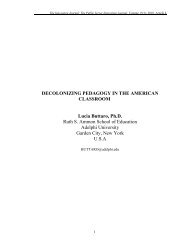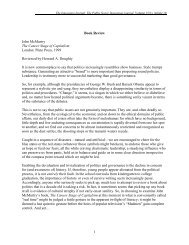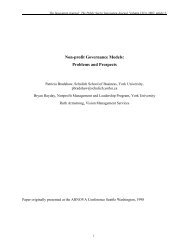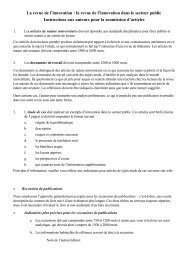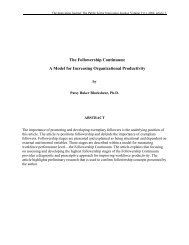What Marketing Managers Need to Navigate the New Environment
What Marketing Managers Need to Navigate the New Environment
What Marketing Managers Need to Navigate the New Environment
Create successful ePaper yourself
Turn your PDF publications into a flip-book with our unique Google optimized e-Paper software.
The Innovation Journal: The Public Sec<strong>to</strong>r Innovation Journal, Volume 18(1), 2013, article 15.<br />
Book Review<br />
David Soberman & Dilip Soman, Eds.<br />
Flux: <strong>What</strong> <strong>Marketing</strong> <strong>Managers</strong> <strong>Need</strong> <strong>to</strong> <strong>Navigate</strong> <strong>the</strong> <strong>New</strong> <strong>Environment</strong><br />
Toron<strong>to</strong>: University of Toron<strong>to</strong> Press, 2012<br />
Reviewed by Howard A. Doughty<br />
In <strong>the</strong> “Foreword” <strong>to</strong> Soberman and Soman’s collection of fifteen lively essays, Roger Martin,<br />
<strong>the</strong> Dean of <strong>the</strong> Rotman School of Management at <strong>the</strong> University of Toron<strong>to</strong>, takes what he<br />
deems <strong>to</strong> be a risk. “While it is dangerous for a management school <strong>to</strong> show favouritism <strong>to</strong> one<br />
scholarly business discipline over ano<strong>the</strong>r, I can claim that sentimentality drives me <strong>to</strong>wards<br />
marketing.”<br />
In that sentence dwell dangers beyond simple sentimentality. They are contained in <strong>the</strong> phrase<br />
“scholarly business discipline.” It is not necessary <strong>to</strong> don <strong>the</strong> habit of a medieval monk <strong>to</strong> be<br />
wary of <strong>the</strong> notion that business “disciplines” are in any serious sense “scholarly.” If nothing<br />
else, <strong>the</strong> term connotes disinterested inquiry in<strong>to</strong> profound questions and <strong>the</strong> quest for at least<br />
provisional truths in traditional human studies and, by relatively recent promotion, <strong>the</strong> natural<br />
and social sciences as well.<br />
Business, on <strong>the</strong> o<strong>the</strong>r hand, may make instrumental use of <strong>the</strong> work of economists,<br />
psychologists and even ethicists when <strong>the</strong> going gets <strong>to</strong>ugh; but, it is hard <strong>to</strong> think of <strong>the</strong> study of<br />
interest rates, commodity markets, real estate transactions, product focus groups and advertising<br />
copy as au<strong>the</strong>ntically “scholarly.” And, among all <strong>the</strong> skills needed <strong>to</strong> succeed in business (with<br />
or without “really trying”), <strong>the</strong> field of marketing—whe<strong>the</strong>r in <strong>the</strong> effort <strong>to</strong> sell pre-owned<br />
vehicles, snack foods, fragrances, vacations or second-hand military hardware—seems especially<br />
far removed from poetics and aes<strong>the</strong>tics, <strong>the</strong> contemplation of justice and <strong>the</strong> good society, or<br />
reflections on <strong>the</strong> order of <strong>the</strong> celestial bodies and <strong>the</strong> creation of <strong>the</strong> heavens.<br />
That, at least, is a caricature of <strong>the</strong> bias of what are sometimes predismissed as traditional<br />
thinkers whose time, as we all know, has long since passed. The absent-minded professor of<br />
philosophy or literature is now only occasionally <strong>to</strong>lerated as an antique curiosity and minimally<br />
indulged in practical academic affairs within great research and teaching universities <strong>to</strong>day.<br />
This, after all, is <strong>the</strong> twenty-first century. The ethos of <strong>the</strong> business world has permeated higher<br />
education no less than any o<strong>the</strong>r aspect of <strong>the</strong> public sec<strong>to</strong>r. Commercialization of research is <strong>the</strong><br />
premise upon which both government and private-sec<strong>to</strong>r funds are delivered <strong>to</strong> chemistry,<br />
engineering and computer science departments. Meantime, <strong>the</strong> measure of a “quality<br />
undergraduate education” in any field is an objective assessment of “cus<strong>to</strong>mer” (formerly<br />
student) satisfaction with <strong>the</strong> “experience” of learning and <strong>the</strong> “value added” in terms of<br />
“marketable skills” among graduates.<br />
1
The Innovation Journal: The Public Sec<strong>to</strong>r Innovation Journal, Volume 18(1), 2013, article 15.<br />
Within colleges and universities, which comprise <strong>the</strong> vast marketplace of mass and, now,<br />
universal education, we are witnessing <strong>the</strong> increased commitment <strong>to</strong> digitalized “delivery<br />
systems” for commodified curricula. Both skills training and even most liberal of <strong>the</strong> liberal arts<br />
are now being refashioned for online and blended courses in which actual attendance on a<br />
campus, much less in a classroom is no longer taken for granted.<br />
Innovation, defined mainly as <strong>the</strong> use of technological means <strong>to</strong> deliver pre-packaged learning<br />
modules <strong>to</strong> passive, isolated and uncritical students is <strong>the</strong> widely acclaimed way of <strong>the</strong> future. So<br />
broadly applicable is this vision of <strong>the</strong> future that few medium-sized or large-scale human<br />
organizations seem exempt. The same business principles are said <strong>to</strong> apply <strong>to</strong> commerce,<br />
industry, resource development, government and even NGOs. There is a presumption of scarcity<br />
and <strong>the</strong> implied inevitability of competition. The primacy of entrepreneurship is ubiqui<strong>to</strong>us. Even<br />
among activist human rights organizations such as Amnesty International and Human Rights<br />
Watch (not <strong>to</strong> mention any number of issue-specific or geographically focused groups) <strong>the</strong>re is a<br />
merciless battle for <strong>the</strong> dollar donations of people inclined <strong>to</strong>ward human mercy.<br />
In <strong>the</strong> public sec<strong>to</strong>r, organized public services from education <strong>to</strong> <strong>the</strong> protection of endangered<br />
species, from law enforcement <strong>to</strong> urban planning, and from transportation and communications<br />
<strong>to</strong> international trade have long since been persuaded <strong>to</strong> abandon antique and often elitist notions<br />
of “professionalism.” They have been encouraged <strong>to</strong> embrace <strong>the</strong> methods and morals of<br />
entrepreneurship. To speak or act o<strong>the</strong>rwise is <strong>to</strong> court charges of heresy against <strong>the</strong> emerging<br />
(post)modernist litany.<br />
Accordingly, books such as Flux must be taken seriously not merely by <strong>the</strong>ir target audience, <strong>the</strong><br />
marketing managers in <strong>the</strong> grand corporations that supply us with kitchen gadgets and wrist<br />
watches, entertainment devices and laundry detergents, but also by medical service providers,<br />
museums and transit system designers. They not only provide marketing managers with an<br />
inven<strong>to</strong>ry of what <strong>the</strong>y “need <strong>to</strong> navigate <strong>the</strong> new environment,” but <strong>the</strong>y also go some distance<br />
<strong>to</strong>ward defining, legitimizing and perpetuating that environment. All <strong>the</strong> while <strong>the</strong>y provide<br />
between <strong>the</strong>ir cloth, paper or virtual covers extraordinary insight in<strong>to</strong> how <strong>the</strong> dominant ideology<br />
of our society insinuates itself in<strong>to</strong> education, and <strong>the</strong>reby replicates itself in government,<br />
commerce, industry and all manner of social formations.<br />
Flux is a very good example of its kind. Its contribu<strong>to</strong>rs are erudite if not always eloquent, highly<br />
knowledgeable and unafraid <strong>to</strong> convey <strong>the</strong>ir messages in sophisticated terminology. They deploy<br />
complex concepts, methods and information. These people do not rely on clichés, slogans and<br />
quotations taken from random forays in<strong>to</strong> Roget’s Thesaurus. They are comfortable with an<br />
elevated breed of quasi-scientific discourse. Their vocabularies are relentlessly professional.<br />
They are sufficiently serious that it is easy <strong>to</strong> forget initial worries about <strong>the</strong>ir scholarship, or<br />
even whe<strong>the</strong>r it matters that <strong>the</strong>y have displaced traditional academic discourse with elaborate<br />
explanations of how best <strong>to</strong> attract consumers <strong>to</strong> a particular brand of life insurance, au<strong>to</strong>mobile<br />
or peanut butter. No lea<strong>the</strong>r elbow patches will be seen on <strong>the</strong>ir jackets. No pipe <strong>to</strong>bacco will be<br />
seen.<br />
2
The Innovation Journal: The Public Sec<strong>to</strong>r Innovation Journal, Volume 18(1), 2013, article 15.<br />
Flux is divided in<strong>to</strong> three convenient <strong>the</strong>matic parts. First, it deals with <strong>the</strong> “changing<br />
landscape.” Then it focuses on <strong>the</strong> implications of recent psychological and economic research<br />
regarding consumer behaviour. Finally, it moves from description and analysis <strong>to</strong> prescription:<br />
How are marketing managers going <strong>to</strong> be able <strong>to</strong> maximize “brand-building,” engage in <strong>the</strong><br />
“productization” of research, develop <strong>to</strong>ols and techniques <strong>to</strong> take full advantage of any bleep or<br />
blip in consumer patterns <strong>to</strong> grab a bigger market share or <strong>to</strong> create products for markets that did<br />
not hi<strong>the</strong>r<strong>to</strong> exist?<br />
In all of this, <strong>the</strong> key word is in <strong>the</strong> title: Flux. The ever-evident assumption is that <strong>the</strong> world is in<br />
a state resembling barely manageable chaos. Realities are changing, perceptions are changing,<br />
and any significant differences between <strong>the</strong> two are disappearing. We are what we purchase. In<br />
this almost on<strong>to</strong>logical circumstance of uncertainty, unpredictability necessarily prevails. How,<br />
<strong>the</strong>n, will it be possible <strong>to</strong> make a buck, or a bundle?<br />
Incidentally, as a great admirer of Lindsay Anderson’s film, “O Lucky Man!, every time I sat<br />
down <strong>to</strong> read ano<strong>the</strong>r chapter of Flux, I needed a musical introduction. Instead, however, of<br />
Frank Loesser’s “The Company Way” from <strong>the</strong> Broadway musical, How <strong>to</strong> Succeed in Business<br />
Without Really Trying, I played Alan Price’s song, “Sell Sell” from <strong>the</strong> soundtrack quite loudly.<br />
With its sardonic Pantagruelian cynicism, it seemed perfect <strong>to</strong> set <strong>the</strong> mood.<br />
The mood, it should be plain, is not one that is overburdened by what many people would call<br />
morality or even ethics. It’s not that <strong>the</strong> authors are consciously complicit in amorality, never<br />
mind immorality; ra<strong>the</strong>r, <strong>the</strong>re is an implicit and generally unders<strong>to</strong>od presumption that this is a<br />
book about methods and not about morals. Even if, however, <strong>the</strong> subject were <strong>to</strong> be raised, <strong>the</strong>re<br />
is an entire library of free market dogma, utilitarianism and “rational choice” economics parked<br />
in <strong>the</strong> ample references <strong>to</strong> each contribution that is ready <strong>to</strong> pop in at any moment and dispense<br />
with, if not quite resolve, any questions and doubts.<br />
The “foundations of marketing,” writes contribu<strong>to</strong>r David Dunne, are <strong>to</strong> “understand your<br />
cus<strong>to</strong>mers and develop actively engaged relationships with <strong>the</strong>m.” Those who understand <strong>the</strong><br />
new environment, replete with social media and <strong>the</strong> opportunity <strong>to</strong> create “viral video,” will find<br />
that <strong>the</strong> opportunities for sales are as<strong>to</strong>nishing. In this context of commercial interaction, it<br />
becomes plain that honesty is not <strong>the</strong> best policy. In fact, it is not a policy at all, it’s a tactic.<br />
Advertising must be entertaining and focused. Engagement must be found “through transparent,<br />
honest, quick, and action-oriented communication. Relate,” <strong>the</strong> marketer is <strong>to</strong>ld, “<strong>to</strong> <strong>the</strong>m [<strong>the</strong><br />
consumers] as people, and not as targets of persuasive campaigns.” The smile must be genuine<br />
and <strong>the</strong> handshake must be firm. There must be unassailable sincerity in ever admonition <strong>to</strong><br />
“have a great day.”<br />
The relevance of <strong>the</strong>se musings <strong>to</strong> <strong>the</strong> public sec<strong>to</strong>r should be clear. In activities from energy<br />
conservation <strong>to</strong> health promotion and from worker retraining <strong>to</strong> armed forces recruitment,<br />
governments are in <strong>the</strong> business of selling <strong>the</strong>ir wares—public services and public regulations—<br />
<strong>to</strong> a body of consumers formerly known as citizens. Making people aware and involved<br />
participants in any number of programs is <strong>the</strong> preoccupation of a large number of public sec<strong>to</strong>r<br />
workers. Sometimes, though this is seldom openly acknowledged, <strong>the</strong> political interests of <strong>the</strong><br />
3
The Innovation Journal: The Public Sec<strong>to</strong>r Innovation Journal, Volume 18(1), 2013, article 15.<br />
ruling party may also be served by public service advertisements which attempt <strong>to</strong> promote<br />
prevailing policies—highlighting successful government initiatives or publicizing already<br />
popular programs. So, in both licit and illicit marketing, <strong>the</strong> public sec<strong>to</strong>r may have a keen<br />
interest in what marketing scholars have <strong>to</strong> say.<br />
And what do Soberman and Soman’s contribu<strong>to</strong>rs say? Though <strong>the</strong> changing landscape can be<br />
seen through a variety of lenses, as it is now fashionable <strong>to</strong> say in <strong>the</strong> relativistic scholarship of<br />
our day, <strong>the</strong> unavoidable frame within which reality is constructed is that of electronic<br />
communication including most obviously <strong>the</strong> Internet as <strong>the</strong> supplier of images and information<br />
and digital media as <strong>the</strong> means <strong>to</strong> access it. Some of <strong>the</strong> flavour of <strong>the</strong> book can be sensed by<br />
sampling only a few of its authors and chapters.<br />
In Part 1, Avi Goldfarb focuses on <strong>the</strong> new communications technology. Anyone expecting a<br />
critical interpretation of some of <strong>the</strong> more troubling or, perhaps, liberating aspects of our<br />
society’s massive investment of personal time in broadband internet use will be disappointed. No<br />
deep existential (are those people on Facebook really my friends?) or even vaguely biological<br />
questions are addressed (do computer screens fry our brains?). Instead, Goldfarb has immediate<br />
and practical questions in mind. He explains how searching <strong>the</strong> net reduces “search costs” for<br />
consumers (we can find anything at our fingertips), allows us <strong>to</strong> shop online which means<br />
anywhere in <strong>the</strong> world (local merchants beware!), and lets us easily “use quantitative data <strong>to</strong><br />
optimize operations and product offerings” (i.e., we can find out more about products and<br />
<strong>the</strong>refore compare both quality and prices). This, he claims, puts pressure on providers and<br />
makes for a buyers’ market, especially when millions of consumers are constantly sharing <strong>the</strong>ir<br />
opinions about <strong>the</strong> quality of goods. Assuming that purchasers are active, informed, canny and,<br />
above all, rational, this means that marketers must learn <strong>to</strong> “leverage” <strong>the</strong> power of <strong>the</strong> Internet<br />
and beat <strong>the</strong> consumer <strong>to</strong> <strong>the</strong> pixel punch. It is, as Hobbes so neatly put it, “a war of all against<br />
all” in <strong>the</strong> lean, mean and highly competitive global market.<br />
In Part 2, Andrew A. Mitchell outlines some current research on memory, persuasion and<br />
decision-making. It is a primer in persuasive communication that somewhat discounts <strong>the</strong><br />
uniqueness of <strong>the</strong> new media and relies on time-tested formulae for propaganda. Its value is not<br />
so much in its discussion of <strong>the</strong> novelty of new technologies, as in its explanation of how<br />
traditional practices of persuasion can best be adapted <strong>to</strong> <strong>the</strong> technical demands of <strong>the</strong> marketing<br />
mechanisms and <strong>to</strong> <strong>the</strong> fluid characteristics of consumers in a digital domain. Today’s advertisers<br />
must keep in mind <strong>the</strong> diversity of <strong>the</strong> audience—especially differences in age—and must be<br />
able <strong>to</strong> attack <strong>the</strong> potential consumer using an entire arsenal of psychological weaponry<br />
combining tactics of repetition, memory-based and stimulus-based messages. Fortunately, so<br />
much data is available about individual consumers and cohorts and about <strong>the</strong>ir perceptions and<br />
sensitivities that even a modest inven<strong>to</strong>ry of sales techniques shows clearly how messages can<br />
achieve <strong>the</strong> greatest impact.<br />
In Part 3, Pankai Aggarwal introduces us <strong>to</strong> one of <strong>the</strong> mildly disquieting implications of finding<br />
ourselves in <strong>the</strong> new landscape, a place where it may not only be difficult <strong>to</strong> distinguish <strong>the</strong><br />
forest from <strong>the</strong> trees, but also ourselves from <strong>the</strong> vegetation. The chapter title is “Brands as<br />
Humans: Relationship Norms and Anthropomorphism.” Aggarwal is nothing if not “engaging.”<br />
4
The Innovation Journal: The Public Sec<strong>to</strong>r Innovation Journal, Volume 18(1), 2013, article 15.<br />
He starts out anecdotally, telling of an employee in an advertising firm where he was once a<br />
senior executive. He relates that <strong>the</strong> fellow felt such affection for <strong>the</strong> Macin<strong>to</strong>sh Apple computer<br />
brand that he had its logo (<strong>the</strong> familiar outline of an apple with a bite out of it) tat<strong>to</strong>oed on his<br />
chest. Such intimacy reminds me of early talk of “cyborgs” though somewhat in reverse. It also<br />
holds intimations of what contemporary futurists call <strong>the</strong> “posthuman era.” As it turns out,<br />
Aggarwal has nothing quite as mind-stretching in s<strong>to</strong>re for us. Instead, we are treated <strong>to</strong> some<br />
revealing case studies in which products are designed <strong>to</strong> “look like” people, particularly when<br />
<strong>the</strong>y have specific “relationships” with individuals and groups. Aggarwal mentions brand<br />
mascots, but makes <strong>the</strong> point most forcefully when describing <strong>the</strong> front ends of au<strong>to</strong>mobiles.<br />
Cars with grilles that pointed up at <strong>the</strong> edges were deemed <strong>to</strong> be “smiling” and <strong>the</strong>refore more<br />
attractive, whereas those with grilles that pointed down at <strong>the</strong> edges were seen <strong>to</strong> be “frowning”<br />
and were <strong>the</strong>refore less attractive.<br />
Of course, in a volume with more than three hundred densely filled pages, <strong>the</strong>re is a tremendous<br />
amount of material—<strong>the</strong>oretical and applied—that cannot be adequately referenced, never mind<br />
described, explained or elucidated here. The final chapters, however, beg mention. In <strong>the</strong><br />
penultimate chapter, Aparna A. Labroo treats “The Psychology of Giving” and shows us how <strong>to</strong><br />
“promote” altruism—useful knowledge for anyone seeking <strong>to</strong> encourage charitable donations or<br />
justify foreign aid budgets. Then, <strong>to</strong> close, Delaine Hamp<strong>to</strong>n returns <strong>to</strong> <strong>the</strong> issues <strong>to</strong> which I<br />
alluded at <strong>the</strong> outset. The last chapter is entitled “Managing Brands by Leveraging Academic<br />
Research.” In it, we are <strong>to</strong>ld once more of <strong>the</strong> need <strong>to</strong> speed up <strong>the</strong> acquisition and utilization of<br />
new knowledge. In Hamp<strong>to</strong>n’s view, academic marketing scientists come up with new<br />
information and ideas which are <strong>the</strong>n transformed in<strong>to</strong> a commercial product, adopted by<br />
companies in <strong>the</strong> private sec<strong>to</strong>r, validated and calibrated, formally adopted within <strong>the</strong> corporate<br />
culture, modified with experience and used <strong>to</strong> shape everyday decisions. The trick is <strong>to</strong> make all<br />
this happen faster. “Accelerated adoption” is <strong>the</strong> key <strong>to</strong> success. And, in marketing, that means<br />
managing <strong>the</strong> “four Ps … price, product, place and promotion.”<br />
In <strong>the</strong> end, <strong>the</strong>n, we can see that a new relationship is speedily evolving. The old dinosaurs’<br />
smug assumption of <strong>the</strong>ir own elite status in <strong>the</strong> ivory <strong>to</strong>wer led <strong>the</strong>m <strong>to</strong> a contemptuous<br />
dismissal of business schools and sneering derision of <strong>the</strong> very notion of marketing scholarship.<br />
No longer adapted <strong>to</strong> <strong>the</strong> new landscape, <strong>the</strong>y are being marginalized and will soon be as extinct<br />
as library card catalogues or personal tu<strong>to</strong>rials.<br />
In <strong>the</strong> Heraclitean flux of private-public partnerships, contracted academic research, <strong>the</strong><br />
commercialization of education and <strong>the</strong> business model of government, distinguishing lines<br />
among <strong>the</strong>se domains are being blurred and a new corporate pyramid is being constructed. The<br />
metamessage in Soberman and Soman’s Flux is that, by force or by consent, we will all soon<br />
know our place.<br />
About <strong>the</strong> author:<br />
Howard A. Doughty teaches political economy at Seneca College in Toron<strong>to</strong>. He can be reached<br />
at howard_doughty@post.com.<br />
5




